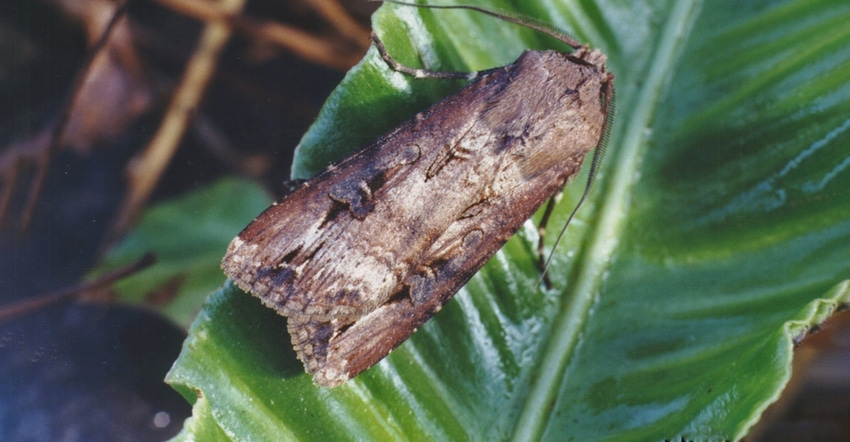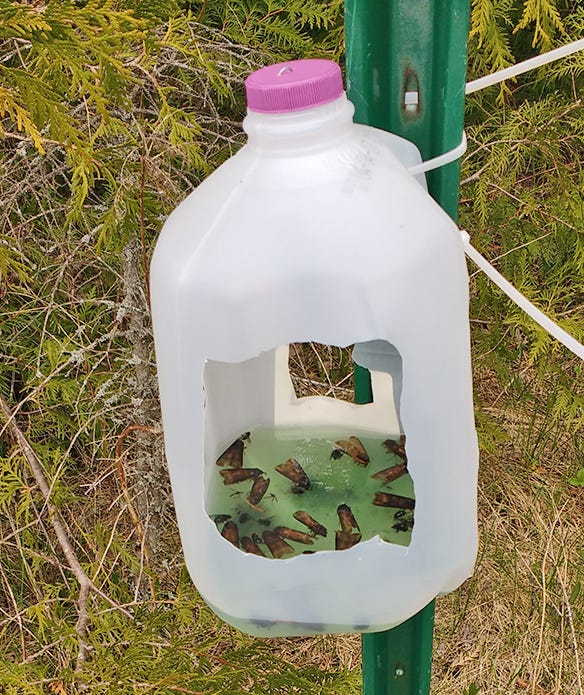April 27, 2018

By Annie Deutsch
A critical component of integrated pest management is detecting the pest’s presence before it causes damage. Often this is done by luring pests into some type of trap. Traps often contain food baits, attractive colors or a pheromone lure.
Pheromones are species-specific chemical signals that many insects produce for aggregation, kin recognition, sending alarm and finding mates. Many moths, in particular, are heavily dependent on pheromone signaling for males to locate females. We can capitalize on this mate-finding behavior for pest management.
Scientists have identified the chemical structure of many insect pheromones. These chemicals can be mass-produced and loaded into dispensers or lures. Lures are often placed in or on a sticky card, in a one-way funnel leading into a container, or above a liquid-filled container. These traps are used to monitor if that insect species is present. For most moth species, the pheromone signal is only produced by the females, and the males follow the scent to locate the females. For this reason, pheromone traps using sex pheromones only catch male moths.

LURING PESTS IN: Pheromone trapping for monitoring purposes is a key component of integrated pest management. This milk jug trap works great for trapping black cutworm male moths. The pheromone lure (out of sight) is hanging from the jug lid.

Pheromone trapping for monitoring purposes is a key component of integrated pest management for several reasons. First, insect populations can be detected at the onset of an infestation when populations are still quite small. Additionally, the emergence of the pest population can be detected throughout a large growing region (e.g., statewide), and that information can help determine the time of peak adult activity at each location. Lastly, pheromone trap catches can allow you to estimate the size of the pest population, and thus its damage potential.
This information allows for targeted scouting and informed decision-making, especially in years with low crop prices. Many predictive degree-day models that track insect development throughout the summer using local temperature data are based on when the first insect of the target species is caught in a pheromone trap.
Black cutworms
One example of an insect pest whose management relies heavily on pheromone trap catches is the black cutworm, a moth pest of economic importance in corn.
Black cutworm overwinters in the Southern U.S., and moths migrate north in weather systems typically in May and early June. When they arrive, female moths begin laying eggs on emerging corn plants or in fields with vegetative cover, including areas with plant residue and weedy or wet patches. As the caterpillars grow, they begin feeding on corn plants. Black cutworm larvae (immatures) go through seven growth stages (instars). Caterpillars in the first to third instar primarily chew holes in corn leaves. By the forth instar, the larvae are large enough to begin cutting corn plants off at the base.
Depending on the size of the caterpillar and the corn plant, one caterpillar can cut up to four corn plants. Luckily, corn is only susceptible to damage until it is at the five-leaf stage.
Due to the spring migration, we do not know when black cutworm moths will arrive until they are here. Early detection is critical to ensure that they do not catch us off guard and cause economic damage that could have been avoided. Pheromone trap catches also allow for better-timed field scouting, so that we are only looking for caterpillars when we know they are active.
Based on pheromone trap catches, an unusually large black cutworm population arrived in 2017. Luckily, despite the large numbers of adults, the number of cut plants was low, and most fields did not need a rescue treatment. The damage potential in 2018 will be determined as the moths start to arrive. But pheromone lures are out in the field as of early April, ready to snag wayward male moths so we can be prepared.
Pheromone traps for black cutworm are located around the state, and counts are consolidated and published in the Wisconsin Department of Agriculture, Trade and Consumer Protection’s weekly Pest Bulletin.
More information about using pheromones and other “scents” for pest management can be found in publication A4135, Utilizing Insects’ Sense of Smell for Pest Management, at the online University of Wisconsin Learning Store. More information about black cutworm management and treatment thresholds can be found in publication A3646, Pest Management in Wisconsin Field Crops.
Deutsch is the Extension agriculture agent in Door County, Wis.
You May Also Like




